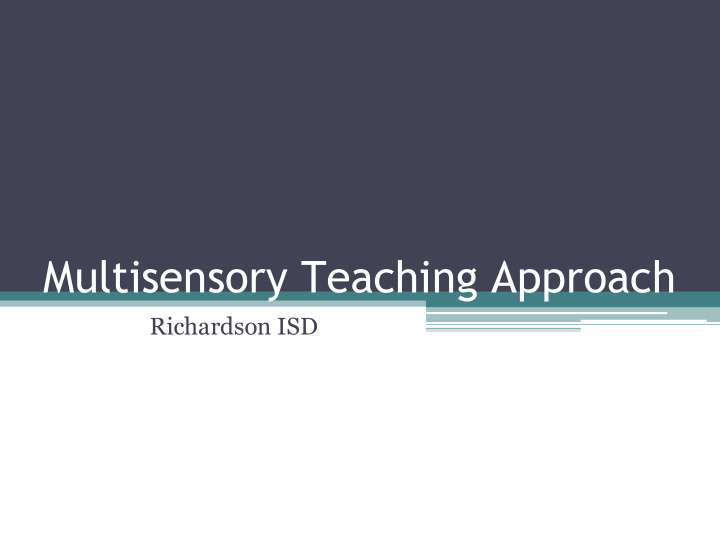



Multisensory Teaching Approach Richardson ISD
What is MTA ? Multisensory Teaching Approach is a program for the remediation of Dyslexia. This program is an Orton- Gillingham multisensory approach to teaching reading that combines Visual, Auditory and Kinesthetic (or muscle) instruction. It is based on the alphabet symbol system, teaching the science of the written language, reading, handwriting, and spelling. The MTA curriculum is thorough in teaching the phonetic structure of the language and also teaching for mastery.
Who is teaching? • A certified teacher trained in MTA instruction
What does a daily MTA lesson include? • Alphabet Practice • Reading and Spelling Decks • New Learning • Handwriting Practice • Reading Practice • Spelling Practice • Verbal Expression • Review
Soundations Introduction into the internal sound structure of words. Helps students make the connection that spoken words are made of blended speech sounds. The phonological awareness instruction consists of: ▫ Segmenting and deleting words in sentences ▫ Recognizing and producing rhyming words ▫ Segmenting, combining and deleting syllables ▫ Categorizing phonemes according to initial and final sounds ▫ Segmenting, deleting and blending phonemes
Language Awareness Language awareness is a variety of activities designed to develop students’ awareness of: • The idea that reading and spelling are talents • History of the development of our alphabet • History of the development of written language • History of the English language • Other communication skills, such as non-verbal language
Alphabet • 4 Basic Skills Developed during Alphabet Practice • 1. Recognition • 2. Sequence • 3. Alphabetizing • 4. Dictionary Usage
Alphabet • What materials are used? • Recognition: alphabet strip and block capital letters • Sequencing: block capital letters, missing letter deck • Alphabetizing: word lists, word cards • Dictionary: Guide Word Dictionary, Webster’s Dictionary
Alphabet • Concepts introduced that support reading and spelling practice: Position of Letters: Initial, Medial or Final Two types of letters: vowels and consonants Directionality: before and after; left and right
Reading Decks • Advanced Reading Deck- shows only the grapheme (letter) • Initial Reading Deck- shows key word prompting student to give the sound for the letter • Purpose: to translate a grapheme (letter) into a phoneme (sound)
Spelling Deck • Purpose: to translate the phoneme (sound) to the grapheme (letter) which it most often represents in initial, medial or final position • Provides daily structured practice in identifying the 44 individual speech sounds and to develop automatic responses to sounds for application to spelling words.
New Learning • Multisensory introduction of a letter or concept in which letters or letter clusters are introduced for reading, writing and spelling • Materials used in letter introductions are linkage paper, writing frames, reading deck cards and a spelling deck card, or concept review cards
Handwriting • Practice in cursive handwriting • Encourages left to right directionality in writing • Teaches 4 approach strokes for cursive handwriting • Emphasis on naming the letter before writing to reduce errors in copying and written expression • Teaches procedures for copying written material from the board or screen in the regular classroom • Materials used are writing frames and lined paper to help with proportion of letters
Reading Practice • Practice in single word decoding and reading words in phrases and sentences. • Ties the reading decks to a reading experience • Teaches students to determine the situation of the vowel- long, short, r-controlled, digraph, or diphthong • Teaches prefixes, suffixes and Greek and Latin roots • Teaches procedures for dividing words into syllables
Reading Practice • Materials used are the MTA reading guides and the MTA phonics reader series
This video clip shows how we use coding marks in MTA to help divide words into syllables and determine vowel sounds:
Spelling • Practice spelling words by applying the sound- symbol relationships learned throughout the Instant Spelling Deck • Teaches rules for spelling phonetic basewords, situational spellings, and word spelling formulas • Teaches procedures for spelling phrases and sentences from dictation • These activities are practiced on white boards, paper and pencil, expo markers on table top
Verbal Expression • Mini-lessons that teach grammar concepts, comprehension skills, language development, and oral and written expression • Concepts are introduced in a systematic order, moving from concrete to abstract concepts beginning with simple activities (such as identifying nouns) and building toward more complex activities (writing a paragraph)
Review • At the conclusion of the lesson, a brief review is given of the day’s new learning. Previously taught concepts are also reviewed. The prefix, suffix, irregular words and root decks are reviewed frequently.
Learning Ally and Bookshare • free audio book resources available to our students with dyslexia • learningally.org • bookshare.org • For more information, contact the dyslexia teacher at your campus
Recommend
More recommend